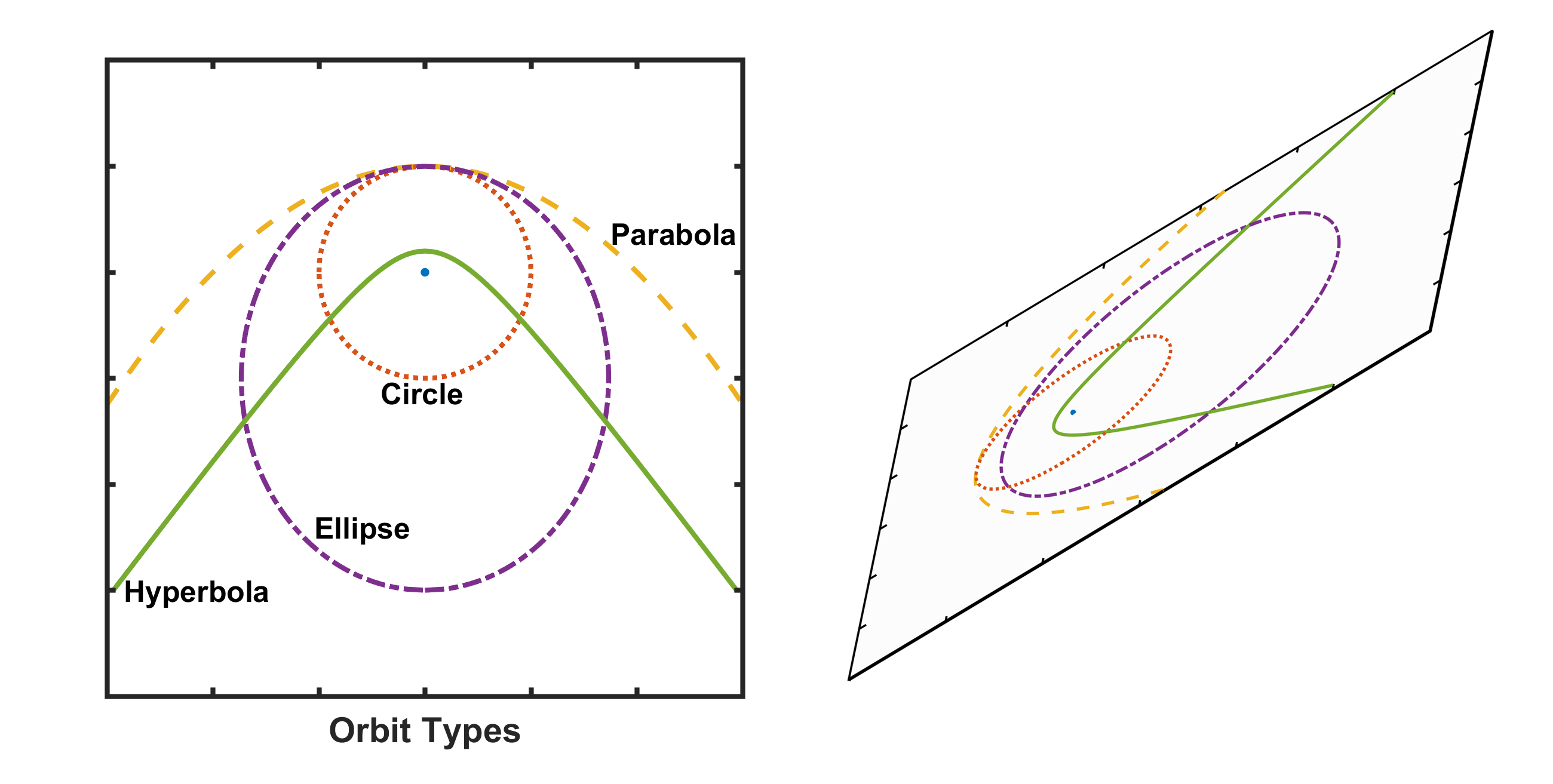News & Resources
09/03/2019
A Launch Four Centuries in the Making

Kepler's work showed that orbits are conic sections, which are all planar shapes.
How does a 400-year-old finding help us understand the right dates to launch the Double Asteroid Redirection Test (DART) spacecraft?
In the early 1600s, German astronomer and mathematician Johannes Kepler developed a theory of astronomy that included three laws of planetary motion. For this discussion, we're interested in the first law, which essentially states that things in orbit move in conic sections (circles, ellipses, parabolas and hyperbolas) about a central body (the Sun). Conic sections are two-dimensional, meaning that they lie in a single plane. And that plane must include the Sun.
This means that DART's transfer orbit from Earth to its target Didymos must lie in a single plane. That plane must contain the Sun, Earth at the time DART launches, and Didymos at the time of impact. Let's look at these three points:
- The Sun – We've already seen that Kepler's first law requires the central body to be in the plane. Once DART is launched, it will orbit the Sun on its way to the impact, so the Sun must lie in the plane.
- Earth (at the time of launch) – DART has to launch from Earth, where it's being built (and what we're trying to protect in the long run). We're still working on the exact date, but we at least know it needs to launch before the impact.
- Didymos (at the time of impact) – The DART impact will occur when Didymos is especially close to Earth, in late September 2022. Don't worry, "close" is relative. It will be more than 6.5 million miles away, or about 27 times farther than the Moon. This range allows Earth-based telescopes to observe the system before, during and after the impact. A Didymos-Earth conjunction this close only happens about twice per century so this is a significant driver in designing the DART mission.
These three points define a plane. That is, if you select a launch date and impact date, DART's orbit plane is fully defined.
In the animation below, this orbit transfer plane is depicted as a green square (top left). The plane contains the Sun, the impact point, and Earth at launch. The Sun and the impact point are constant, but the launch date is varied, moving around Earth's orbit throughout dates prior to the impact. Earth's and Didymos' orbits are also illustrated.

This animation shows the dependence of DART's orbit transfer plane on the choice of launch date. The top left illustration shows the transfer plane as a green square. The top right illustration shows the same geometry, but from a view oriented with the impact point (in this view, the green plane appears as a green line). The bottom figure shows the corresponding inclination. Favorable launch periods are located where the inclination is small.
The transfer orbit plane is nearly parallel to Earth's orbit for most of the time, but experiences a fast flip/rotation during certain seasons. At these times, the plane swings up to be orthogonal to Earth's orbit plane (vertical in the illustration).
The impact point at Didymos is "below" Earth's orbit (where "up" is defined as positive for Earth's orbit angular momentum vector). At the times when the three points are almost in a line, the transfer plane has to be vertical to connect them all. When the three points form an "L" and Earth is 90 degrees away from the impact point, the transfer plane is very similar to Earth's orbit plane.
So what? The angle between Earth's orbit plane and the DART transfer orbit plane is called the orbit inclination. When the green plane is horizontal, the inclination is low. When the green plane is vertical, the inclination is high. High values of inclination require a lot of launch energy. So we want to avoid launching on dates that require a high inclination transfer orbit.

Inclination is a measure of the angle between two planes. In this case, it's the angle between Earth's orbit plane and DART's transfer orbit plane.
It turns out, for DART, this is the predominant driver for determining the feasible launch dates. There are a few other factors related to the impact geometry, but inclination is the most important parameter. This is why the DART team is working toward two finite launch periods: summer 2021 and winter 2021/2022. Having two launch periods gives us some resilience to unplanned anomalies (since we are demonstrating new technologies) or launch weather (like high winds or large storms).
So Kepler gave us four centuries of "heads up" for when we need to launch. And we're enthusiastically marching toward those launch dates so that we can get DART to Didymos in time for the 2022 impact.
